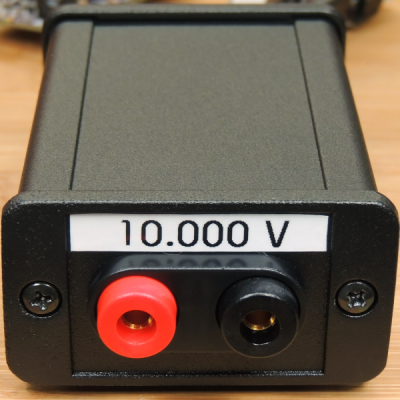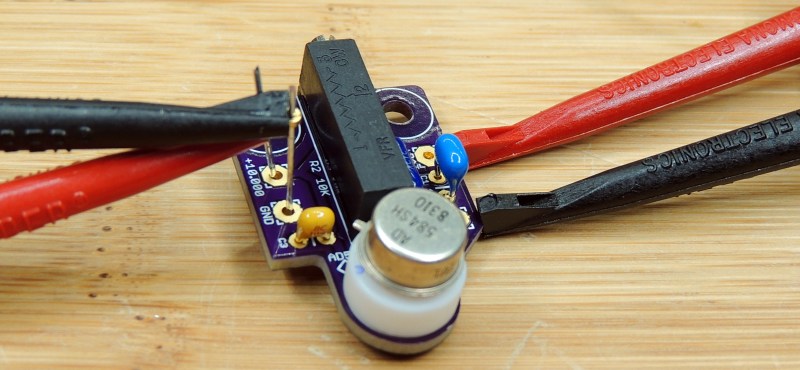[barbouri] found a few old (vintage?) parts from the early ’80’s while rummaging through his parts bin, and quickly spun out a small PCB to build a 10.000 V reference using these old ICs. Throwing together a small number of parts, he was able to build a source which might be good enough to use as a reference for another circuit or provide a quick calibration check for some of his bench instruments that have a resolution of 1 mV or maybe even 100 μV.
 The AD584* pin programmable precision voltage references have been available since the ’80’s and offer four programmable output voltages of 10.000 V, 7.500 V, 5.000 V, and 2.500 V. The chip is laser-trimmed to ensure high accuracy and low temperature coefficient and requires just a few external components to function. It is available in TO-99 hermetically sealed metal can and 8-pin DIP variants. The “S” version of the device that [barbouri] used provides a temperature coefficient of 30 ppm/°C max over a -55 °C to +125 °C temperature range but other versions of the chip offer a better stability. Analog Devices seem to have discontinued the “L” version (pdf), since it is no longer listed in the current data sheet, but you can still get them from a few sources. The “L” version has a temperature coefficient of just 5 ppm/°C.
The AD584* pin programmable precision voltage references have been available since the ’80’s and offer four programmable output voltages of 10.000 V, 7.500 V, 5.000 V, and 2.500 V. The chip is laser-trimmed to ensure high accuracy and low temperature coefficient and requires just a few external components to function. It is available in TO-99 hermetically sealed metal can and 8-pin DIP variants. The “S” version of the device that [barbouri] used provides a temperature coefficient of 30 ppm/°C max over a -55 °C to +125 °C temperature range but other versions of the chip offer a better stability. Analog Devices seem to have discontinued the “L” version (pdf), since it is no longer listed in the current data sheet, but you can still get them from a few sources. The “L” version has a temperature coefficient of just 5 ppm/°C.
Using quality parts such as high stability resistors and TO-99 PTFE socket with gold-plated contacts, his observations confirm that the unit is stable within 30 μV, with a very slow voltage increase of a few microvolts every 6 hours. A 15 V linear regulator powers the device with input power coming from an external wall wart. A small aluminum enclosure houses the device, with two gold-plated 4 mm sockets for the output. If you would like to build your own, his board design is hosted on OSH park, or you can download the Eagle CAD design files. He’s posted all links on his blog post, and provides part numbers for all of the parts used. [barbouri] has been doing a good job of building handy devices for his work bench – check out his well-built milli Ohm Meter that we had featured earlier.















I have a few of these and the L versions are indeed much more stable if you can find them but one thing to note here is that if you are been such a volt nut the REF is rarely bang on 2.5/5/7.5/10 so you should measure the reference initially (preferably at a given known temp!) and use that to mark up what the reference is,e.g 9.99425 blah Volts rather than just the boiler plate 10V that way you get the accuracy of the Ref rather than just some assumption.
how do people measure voltages this low? My tek scope with its probe grounded still reads 2mv pk to pk.
Oscilloscopes are good at fast measurements, but not that great at accurate measurements. You would typically use a good multimeter for something like this. Even though it wouldn’t be the tool of choice for something like this, the well known Fluke 87V can measure these voltages up to and including three decimals. The famous HP/Agilent/Keysight 3458A can measure up to eight decimals, so 2,50000000, but those things are very expensive and even just calibration costs more than said Fluke.
What would you use to quantify noise in the MV region? My multimeter averages it out, and the noise I see on the scope is there even when disconnected.
Spectrum Analyzers are designed to measure extremely small signal (it’s normal in the RF world to care about uV or even nV of noise). These instruments are very sensitive and are considerably more expensive than oscilloscopes
Whoops, I initially read that as “10000” volts (in my region, the dot followed by three places usually means thousands). Would make for one impressive voltage reference..! :-D
Doubt you’d find something like that in an enclosure with so little insulation and with terminals so close together! I thought the same thing for a second though.
Joe Geller used to sell nice little voltage references like this. Some great documentation is still on his site: http://gellerlabs.com/Voltage%20References.htm
AD584 based references are available on ebay – most break out all the pins, not just the 10v. Useful tool for the workbench.
Once upon a time they used to make great electronic parts. But many years aho a bad dragon started to flood the market with crap and poo.